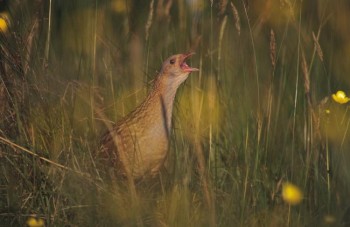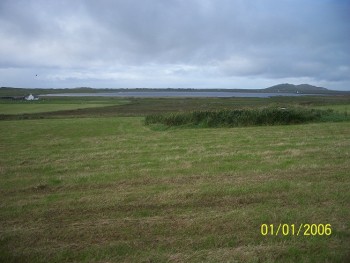Supporting guidance for Corncrake Mown Grassland
Date published: 14 December, 2015
To see recent changes to this guidance, check the bottom of this page.
Introduction
The corncrake is a ground-nesting bird, related to moorhens and coots, that lives on dry land. It is a summer visitor to Scotland, over-wintering in Africa.
To survive and breed successfully, corncrakes need:
- safe nesting habitat in crops and hay / silage fields
- tall vegetation (ideally over 20 centimetres in height) that provides cover during breeding and chick rearing

Corncrake – Credit: RSPB, Chris Gomersall
The aim of this option is to provide both tall vegetation cover from the mid- to late-season and safe nesting habitat, with delayed and corncrake-friendly mowing to prevent nest and bird destruction. Only grassland you intend to mow should be entered into this option.
Corncrakes use long vegetation as cover for breeding from spring until late-summer and research shows that delaying the date of mowing can increase breeding success markedly.
Mowing from the inside of the field outwards (the reverse of the usual practice), or using another method that allows chicks to escape, increases the number of chicks that survive mowing.
Providing cover
Ceasing agricultural operations, including grazing, from 15 May will allow corncrake to use the grassland for breeding without disturbance.
Ideally, the sward height should be at least 20 centimetres through the main part of the summer. You may need to add nutrients to achieve this.
Get soil tests carried out and ask for advice on whether applying fertiliser and / or lime would be appropriate for your grassland. Any applications should be carried out before 15 May.
Delayed and corncrake-friendly mowing
Three cutting dates are offered in the option: 1 August, 15 August and 1 September.
Corncrakes are at high risk of being killed when fields are mown so choose as late a cutting date as possible without compromising your farm operations. Early mowing can also destroy nests.
Up to about 60 per cent of chicks are killed by usual mowing practices because birds are reluctant to escape across parts of the field that are already cut. Cutting fields in a ‘corncrake-friendly’ manner can reduce this risk substantially.

Corncrake-friendly mowing
- cut the fields from the centre of the field towards the edges. This will avoid driving birds into a central island of grass where they are likely to be killed as the last cut is taken
- leave an uncut strip at least two metres wide around the field edges to provide an escape route for birds. If your field is under 40 metres wide, you can leave the uncut strip on one long side of the field. Ensure your cutting operations drive the birds towards this strip and not away from it
Which fields to choose
Returning corncrake settle in plots containing tall herbs before moving into larger hay meadows and silage fields as the grass grows. Corncrake do not like to break cover as they move from one field to another.
Therefore, corncrake mown grassland fields are most effective if they are adjacent to plots providing early cover. Unless you receive prior approval to use an alternative location as part of the application process, select fields that are adjacent to plots that can be managed under one of the following options:
The Creation of Cover for Corncrakes capital item could also be used adjacent to this option.

Corncrake habitat – Credit: RSPB
How to increase the success of this option
In some cases this option will work better where stock is removed before 15 May, possibly as early as 1 April. However, we suggest you seek advice as earlier stock removal will not be appropriate for all sites.
What else benefits from this option
In addition to corncrakes delayed mowing benefits a range of other species such as other meadow-nesting birds species such as skylark and curlew, bumblebees, spiders, beetles, brown hare and other small mammals, such as voles.

Skylark – Credit: Andy Hay – © RSPB images

Great yellow bumble bee – Credit: MIked Edwards – © RSPB images
Further information
For further information on corncrake conservation contact the RSPB advisory services on 0131 317 4100 or your local Scottish Natural Heritage office.
Recent changes
| Section | Change | Previous text | New text |
|---|---|---|---|
| Introduction | Clarification of what grassland should be entered into the option. | The aim of this option is to provide both tall vegetation cover from the mid- to late-season and safe nesting habitat, with delayed and corncrake-friendly mowing to prevent nest and bird destruction. | The aim of this option is to provide both tall vegetation cover from the mid- to late-season and safe nesting habitat, with delayed and corncrake-friendly mowing to prevent nest and bird destruction. Only grassland you intend to mow should be entered into this option. |
| Delayed and corncrake-friendly mowing | Clarification of corncrake-friendly mowing. | • leave a two metre uncut strip around the field edges to provide an escape route for birds. If your field is under 40 metres wide, you can leave the uncut strip on one long side of the field. Ensure your cutting operations drive the birds towards this strip and not away from it | • leave an uncut strip at least two metres wide around the field edges to provide an escape route for birds. If your field is under 40 metres wide, you can leave the uncut strip on one long side of the field. Ensure your cutting operations drive the birds towards this strip and not away from it |
| Which fields to choose | Clarification of which fields to choose. | Therefore, corncrake mown grassland fields are most effective if they are adjacent to plots providing early cover. Select fields that are adjacent to plots that can be managed under one of the following options: | Therefore, corncrake mown grassland fields are most effective if they are adjacent to plots providing early cover. Unless you receive prior approval to use an alternative location as part of the application process, select fields that are adjacent to plots that can be managed under one of the following options: |
Previous versions
Download guidance
Click 'Download this page' to create a printable version of this guidance you can save or print out.
